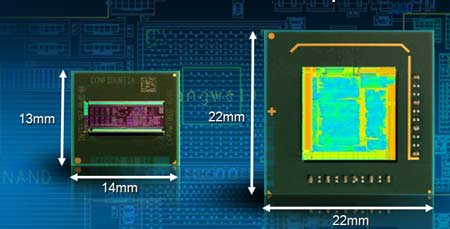Intel Fires Up New Atom Processors
Intel Fires Up New Atom Processors
Technical highlights - Software: Betting on Linux
Atom runs an x86 software stack that is compatible with Intel's current mobile processors. As a result, you will be able to run any software on the MID that also runs on a Core 2 Duo notebook. This is actually significant, if you think about the fact that there is a changed software stack for every new ARM processor, which is Atom's main rival. There are virtually hundreds of different versions of popular software such as Adobe's Flash for different versions of cellphones, smartphones and PDAs. This is not just a pain in the you know what for developers but it limits the choice of applications for users of these devices as well.
Standardizing this platform on x86 opens the complete world of x86 applications to Atom MIDs. As long as you can live with the smaller display, you can install anything from Firefox, Skype (Intel says there will be a special version of Skype for MIDs), Google Earth, office applications and well, if you really want to, games and Photoshop.
Dumping Windows
The fact that Atom's software stack is compatible with Merom also means that you can install any x86 operating system. Intel heavily pitches two Linux products for MIDs: Both were optimized through Moblin.org and represent an Ubuntu variant on the one side and Asianux (which includes Red Flag Linux, Miracle Linux and HannSoft) on the other. According to Intel, Moblin.org Linux versions are based on Linux-based software stack (Kernel, middleware layer, API layer) using open source (Kernel, media framework) and closed source (codecs, DRM) components. Whenever Intel has shown an MID at an event in the past two years, it typically had Ubuntu installed on it and it appears that this will be the software that Intel prefers on these shores.
But what about Microsoft and Windows? Yes, you can run Windows on an MID and there will be MID versions that come with Windows Vista. But a Windows Vista MID will require the expensive high-end version of Atom. While a Linux MID can run on a $45 Atom+SCH system, the same Atom platform for Windows will cost $160. And not only is it more expensive, it also has a 20% higher TDP (2.4 watts instead of 2 watts) than the "Linux" Atoms.
The only Windows SKU (1.86 GHz) is priced at a 68% premium over the most expensive Linux SKU (1.6 GHz, $95), which means that Windows MIDs will be substantially more expensive than Linux versions. Intel told us that Linux MIDs will debut at a $499 (and higher) price point, while Windows versions will start at $599. A downside of these Windows MIDs is also the fact that Vista will need a lot more storage space than Linux, so count on purchasing a larger SSD or a hard drive version of an MID, if you are interested in such a device.
Get Tom's Hardware's best news and in-depth reviews, straight to your inbox.
We asked Intel why this 1.86 GHz SKU is so expensive, given the fact that the effective production cost should not be substantially more than any other Silverthorne chip (yields are rumored to be very high). The answer of the firm's director of global ecosystem programs for MIDs, Pankaj Kedia, was, well, diplomatic: "Production cost does not determine the price." In other words, Intel is charging what it can get for these processors, but especially $160 still seems a bit high to us, given the fact, that you can buy 45 nm Wolfdale CPUs for the same money.
The premium is high enough, in our opinion, to make this a very unattractive SKU for the MID market and reserve this particular product for the low-volume UMPC market. Remember that this SKU is the only version that will be able to run Windows Vista, which could mean that this move effectively shuts out Microsoft from the MID market - a market that Intel expects to be about 50x the size of the UMPC market within a few years. Obviously, Intel did not care much about Windows during our conversation and said that Windows is pricey and people really don't care about the OS that is running on a device such as an MID.
Kedia said that Intel is "working with Microsoft", but he has no idea what Microsoft's strategy for MIDs is. "It will be interesting to see which way they will go. But right now, we really don't know."
This story certainly sounds different than what we heard at the UMPC launch. Back then, Microsoft's Origami marketing campaign virtually screwed Intel and device manufacturers when it promised a product that had nothing to do with the products that were coming to market. Today, it looks like Intel has decided to do what it thinks is the best software approach for MIDs this time, regardless of what is available from Microsoft.
Think about it: If MIDs will be as successful as Intel hopes they will be, Microsoft would have no way to get its current generation operating system onto a significant number of these devices. It could be the very first time that Linux will beat Microsoft on a mass-market consumer computing platform.
Time will tell whether it was a good idea for Intel to leave Microsoft behind and bet everything on Linux.
Current page: Intel Fires Up New Atom Processors
Prev Page Intel Fires Up New Atom Processors Next Page Performance estimates: Almost a Pentium M at a fraction of the power
Wolfgang Gruener is an experienced professional in digital strategy and content, specializing in web strategy, content architecture, user experience, and applying AI in content operations within the insurtech industry. His previous roles include Director, Digital Strategy and Content Experience at American Eagle, Managing Editor at TG Daily, and contributing to publications like Tom's Guide and Tom's Hardware.
